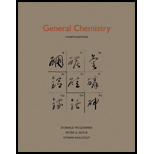
Concept explainers
(a)
Interpretation:
Mass
Concept Introduction:
Mole is S.I. unit. The number of moles is calculated as ratio of mass of compound to molar mass of compound.
Molar mass is sum of the total mass in grams of all atoms that make up mole of particular molecule that is mass of 1 mole of compound. The S.I unit is
The expression to relate number of moles, mass and molar mass of compound is as follows:
Mass percent is calculated by the mass of the element divided by the mass of compound and multiplied by 100.
The formula to calculate mass percentage of substance is as follows:
(a)
Answer to Problem 11.6P
Mass
Explanation of Solution
The compound is
The formula to calculate mass
Substitute
Therefore, mass
The formula to calculate mass
Substitute
Therefore, mass
The formula to calculate mass
Substitute
Therefore, mass
(b)
Interpretation:
Mass
Concept Introduction:
Refer to part (a).
(b)
Answer to Problem 11.6P
Mass
Explanation of Solution
The compound is
Molar mass of
The formula to calculate mass
Substitute
Therefore, mass
The formula to calculate mass
Substitute
Therefore, mass
(c)
Interpretation:
Mass
Concept Introduction:
Refer to part (a)
(c)
Answer to Problem 11.6P
Mass
Explanation of Solution
The compound is
The formula to calculate mass
Substitute
Therefore, mass
There are 2
Molar mass of
The formula to calculate mass
Substitute
Therefore, mass
(d)
Interpretation:
Mass
Concept Introduction:
Refer to part (a).
(d)
Answer to Problem 11.6P
Mass
Explanation of Solution
The compound is
Molar mass of
The formula to calculate mass
Substitute
Therefore, mass
The formula to calculate mass
Substitute
Therefore, mass
The formula to calculate mass
Substitute
Therefore, mass
The formula to calculate mass
Substitute
Therefore, mass
Want to see more full solutions like this?
Chapter 11 Solutions
General Chemistry
- Identify the compound with the longest carbon - nitrogen bond. O CH3CH2CH=NH O CH3CH2NH2 CH3CH2C=N CH3CH=NCH 3 The length of all the carbon-nitrogen bonds are the samearrow_forwardIdentify any polar covalent bonds in epichlorohydrin with S+ and 8- symbols in the appropriate locations. Choose the correct answer below. Η H's+ 6Η Η Η Η Η Ηδ Η Ο Ο HH +Η Η +Η Η Η -8+ CIarrow_forwardH H:O::::H H H HH H::O:D:D:H HH HH H:O:D:D:H .. HH H:O:D:D:H H H Select the correct Lewis dot structure for the following compound: CH3CH2OHarrow_forward
- Rank the following compounds in order of decreasing boiling point. ннннн -С-С-Н . н-с- ННННН H ΗΤΗ НННН TTTĪ н-с-с-с-с-о-н НННН НН C' Н н-с-с-с-с-н НН || Ш НННН H-C-C-C-C-N-H ННННН IVarrow_forwardRank the following compounds in order of decreasing dipole moment. |>||>||| ||>|||>| |>|||>|| |||>||>| O ||>>||| H F H F H c=c || H c=c F F IIIarrow_forwardchoose the description that best describes the geometry for the following charged species ch3-arrow_forward
- Why isn't the ketone in this compound converted to an acetal or hemiacetal by the alcohol and acid?arrow_forwardWhat is the approximate bond angle around the nitrogen atom? HNH H Harrow_forwardOH 1. NaOCH2CH3 Q 2. CH3CH2Br (1 equiv) H3O+ Select to Draw 1. NaOCH2 CH3 2. CH3Br (1 equiv) heat Select to Edit Select to Drawarrow_forward
- Complete and balance the following half-reaction in acidic solution. Be sure to include the proper phases for all species within the reaction. S₂O₃²⁻(aq) → S₄O₆²⁻(aq)arrow_forwardQ Select to Edit NH3 (CH3)2CHCI (1 equiv) AICI 3 Select to Draw cat. H2SO4 SO3 (1 equiv) HO SOCl2 pyridine Select to Edit >arrow_forwardComplete and balance the following half-reaction in basic solution. Be sure to include the proper phases for all species within the reaction. Zn(s) → Zn(OH)₄²⁻(aq)arrow_forward
 ChemistryChemistryISBN:9781305957404Author:Steven S. Zumdahl, Susan A. Zumdahl, Donald J. DeCostePublisher:Cengage Learning
ChemistryChemistryISBN:9781305957404Author:Steven S. Zumdahl, Susan A. Zumdahl, Donald J. DeCostePublisher:Cengage Learning ChemistryChemistryISBN:9781259911156Author:Raymond Chang Dr., Jason Overby ProfessorPublisher:McGraw-Hill Education
ChemistryChemistryISBN:9781259911156Author:Raymond Chang Dr., Jason Overby ProfessorPublisher:McGraw-Hill Education Principles of Instrumental AnalysisChemistryISBN:9781305577213Author:Douglas A. Skoog, F. James Holler, Stanley R. CrouchPublisher:Cengage Learning
Principles of Instrumental AnalysisChemistryISBN:9781305577213Author:Douglas A. Skoog, F. James Holler, Stanley R. CrouchPublisher:Cengage Learning Organic ChemistryChemistryISBN:9780078021558Author:Janice Gorzynski Smith Dr.Publisher:McGraw-Hill Education
Organic ChemistryChemistryISBN:9780078021558Author:Janice Gorzynski Smith Dr.Publisher:McGraw-Hill Education Chemistry: Principles and ReactionsChemistryISBN:9781305079373Author:William L. Masterton, Cecile N. HurleyPublisher:Cengage Learning
Chemistry: Principles and ReactionsChemistryISBN:9781305079373Author:William L. Masterton, Cecile N. HurleyPublisher:Cengage Learning Elementary Principles of Chemical Processes, Bind...ChemistryISBN:9781118431221Author:Richard M. Felder, Ronald W. Rousseau, Lisa G. BullardPublisher:WILEY
Elementary Principles of Chemical Processes, Bind...ChemistryISBN:9781118431221Author:Richard M. Felder, Ronald W. Rousseau, Lisa G. BullardPublisher:WILEY





